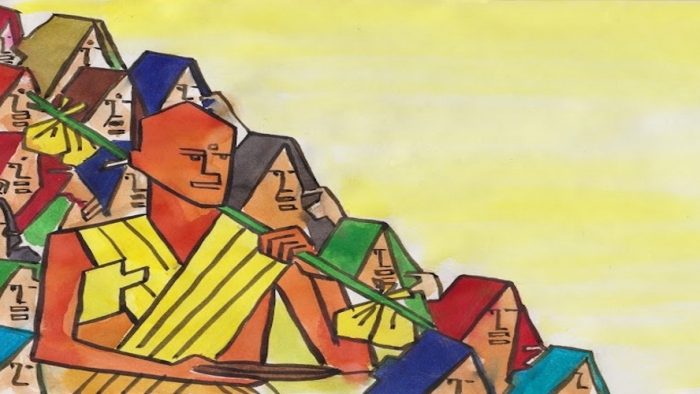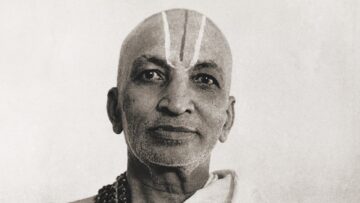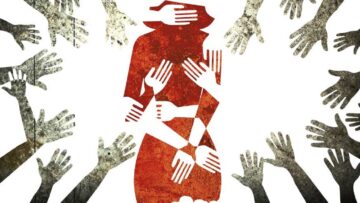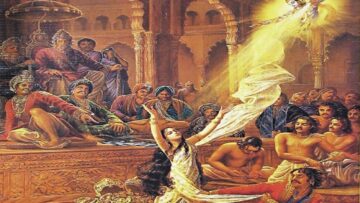We are all aware about Yogacharya T.Krishnamacharya being a pioneer in using yoga (specifically asana and prANAyAma) for therapy and well-being. But little did we know that he was a great scholar of our sacred knowledge and traditions. One of his long-standing students Raghu Ananthanarayanan has put together an interesting note about how can one use yoga as a tool for deeper fulfillment and meaning in life? He has used the device of an innocent conversation between a young, curious child, Chiku who is Gayatri Iyer, and an elderly teacher Rita, just like the dialogues that used to take place between student and teachers at ashrams. In my discussions with Raghu who is Rita in the writings, I learnt how symbols and rituals of our Hindu culture have been misinterpreted for long and once you know the real meaning, you can only marvel at the profundity of the entire meaning and how it is part of the larger divine order.
In the first part of the Upanayanam series we looked into the meaning and the importance of this ancient Hindu ritual. In this concluding part, Chiku and Rita through their conversation take us further into the various aspects of the Upanayanam sanskar and try and address certain doubts and delve on responsibilities. Here we pick up right after the child is taught the Gayatri mantram by his father, which is called the Brahmopadesham and he asks his mother for alms for nourishment saying “bhavati bhikShAm dehi”.
Chiku: It is very moving Rita
Rita: In homes where the true meaning of these words is understood, the mother may cry because up till now the child was dependent on her and the family, almost like taken for granted. But not any more because the child must stand on his or her own feet and contribute to the society.
Chiku: But I also saw my cousin seek something from other elders too.
Rita: Yes, after that he goes to others to seek, it is mature in a way because one must be deserving enough to receive something. After that the child goes into a period of study with a Guru before he starts contributing to society.
Chiku: How long is this study period?
Rita: 12 years, which is the period young children used to go and live with Gurus in the ashrams. Krishnamacharya used to say that if the child remains in the parental home after the age of 12, then all the samskAra of the family and context will keep getting re-enforced again and again. When the child goes away, there is a possibility to end some of these patterns and create new samskAra.
By the age of 5, all the vAsanA which you must deal with in this life has got set. The rest of the life is spent watching these and burning them away. This is called prArabdha karma.
Chiku: This sounds like a futile purpose of living
Rita: There is hope if you move away from your current context which may not allow you to see these vAsanA insightfully.
Chiku: But how can I control what I absorb before the age of five?
Rita: You can’t, because it is all done unconsciously without understanding the consequences. By 12, your intellect allows you to interpret yourself, how things have happened or happening. So, if I continue to live in the same environment it would be very difficult for me to understand what has happened and why I behave the way I do?
Chiku: There must be something in the ceremony for the elders or parents too? Their role?
Rita: Yes, they would seriously reflect on ‘what is my purpose in my child’s life, how do I enable him/her to become conscious of their own path, how can I help to make this process more meaningful?’
Chiku: I think it is also a time for the parents to reflect on what kind of conditioning have they re-enforced on the child etc, how has the relationship evolved etc.
Rita: In Tamil tradition, there is a saying that once the son reaches the father’s height he must be treated as an equal. So, all the relationships with family and the world are being punctuated through these rituals.
Chiku: I have also heard of sandhya vandanam that the child must do every day?
Rita: This has three parts to it-:
- Rituals to cleanse the outer or the body through water and chants. The body being the instrument for all our actions is cleansed.
- The psychological cleansing.
- Emotional cleansing.
After all this, one needs to do dhyAna, reconnect with the energy of the sun (the sun’s energy is the purest and most powerful energy which is available to us from nature) to help you in your tapas. After that you invite other devA to help you just like the upanayanam ceremony.
There is also an agni homam which signifies the kindling of your own agni inside in a healthy manner to help you in the tapas
Chiku: But how does one practice it in the current context? I don’t think my cousin has any clue why he needs to do it.
Rita: Doing anything ritualistically without understanding the deeper meaning is not useful. But at the same time dropping such beautiful meaningful transitional practices is also not good. So, I suggest we bring back the concept of nitya karma and naimittika karma.
Chiku: What is that?
Rita: That means you sit and reflect on yourself, your actions, samskArA on which you are dependent etc. You can also reflect on how are you asserting yourself daily? How am I establishing myself as a separate entity? Lastly, ask how are you preparing to contribute meaningfully to society? The purpose and meaning of your life in the world today?
Chiku: These are very essential questions that all of us need to ask.
Rita: Yes, only then do we carve out a path towards the truth.
Chiku: But what about being a hunter, soldier etc?
Rita: The outer roles never determined the inner journey. The outer training is different but the inner work is similar.
Chiku: These questions are very relevant for anyone truly wanting to grow and transition.
Rita: In fact, elders in a system help you go through the inner churn by being supportive to where you are and want to be.
Chiku: Sometimes I miss this in my family because no one understands the inner churn that I go through!
Rita: Yes, this is the unfortunate consequence of living in nuclear families. When one lives in a large family there is always some one who can be a good mentor.
Chiku: But I can also do the same with my yoga sAdhana of AsanA, prANAyAma and dhAraNA no?
Rita: Yes, yoga talks about how the mind, body and psyche are holders of trapped energies once we keep repeating our patterns. Unless, I work with my body through AsanA, breath through prANAyAma I cannot release these energies and channelize them into a serious enquiry. devA refers to the inner energies rather than external forces.
When you do a naimitikka karma like an upanayanam you emphasize these factors much more than say a daily yoga practice.
Chiku: I have also seen many people do the upanayanam before they get married
Rita: The day before the marriage the ritual is done again to cleanse oneself of any past residues so that you enter the new phase of life and context as clean as possible.
Chiku: Why do they increase the number of threads after marriage and death of the father?
Rita: In a marriage, the man agrees to undertake all the duties on behalf of the woman but don’t forget that in every Hindu ritual the wife has to bring the agni to start the yagna, so her role is very important. The darbha grass held by the woman above her husband’s shoulders is the convergence of both their energies. So, it is not a man’s thing only!
When the father dies, he takes on the responsibility of the father’s duties too. Each stage of life the thread increases- brahmacarya is 1, grihastha is 2 and when one’s father passes away it is 3. It is a constant reminder and re-enforcement of your larger purpose in life.
Chiku: I really like how we invoke the devA to help us. It is a tough journey and ‘me’ alone cannot undertake it.
Rita: Yes, if you are serious about your life and truth you would seek the right guidance
Chiku: Why is it a community event?
Rita: It helps others around you to see what path are you going to pursue and how should they now relate to you.
Chiku: Yes, I do not like to be preached all my life.
Rita: Correct, if you have decided to cross the threshold then others ought to respect your decision.
Chiku: How else can we use this in our daily life? Work?
Rita: In an organization, when someone gets promoted to the next senior position, the transition needs to be handled very carefully because one needs to re-look at the past habits or ways and how should one act in the new role. Upanayanam is also about how transitions thresholds through one’s life.
Chiku: I remember the growing pains or irritation I used to have when so many of my old habits used to keep coming up again and again, because I chose to grow.
Rita: And you took the transition seriously.
Chiku: It is touching at one level, how the family and community supported the child to find his/her own path. But I am not sure such a solid support system is now available for children?
Rita: Yes, the context has changed drastically since the time such rituals were introduced to now. May be, the Hindu community became very conservative and focused on preserving the ritual.
Chiku: Why aren’t girls allowed to do an upanayanam?
Rita: This is controversial but all I can say is that there are sculptures around mid-10th-11th century that show women also wearing the thread. So, even women were initiated into the process but along the way they were disallowed.
But you can still do it in a very simple way; Krishnamacharya used to say you can do ritual like sandhya vandanam three times a day i.e. each time when the position of the sun transitions into dawn, mid-day and evening. A simple AsanA/prANAyAma to start cleansing the body, disengaging from all distractions, settle the emotions. This is followed by dhyAnA on the sun’s energy inside you to kindle the fire to get through the day. The morning practice can start with a sankalpa or intention on what do you want to achieve? Mid-day you can ask how has your progress been so far? Any corrections? In the evening you can reflect on the entire day. This would take you 10-15 minutes every day.
Chiku: Do you do sandhya vandanam daily?
Rita: I did it for some time and then I gave it up because no one could tell me why should I continue doing the sandhya vandanam. Once I started studying with Krishnamacharya I understood the meaning and then, I picked it up again. But I always had and still have a practice of AsanA, prANAyAma, dhAraNA, chanting spread out during the day.
Chiku: I think this is the best way to preserve and continue the tradition today.
Rita: if the ritual does not trigger something deep inside, then it would only be an activity. By understanding the meaning, reflecting on how and where you can use it in your life is the only way you can respect the tradition.
Disclaimer: The opinions expressed in this article belong to the author. Indic Today is neither responsible nor liable for the accuracy, completeness, suitability, or validity of any information in the article.










